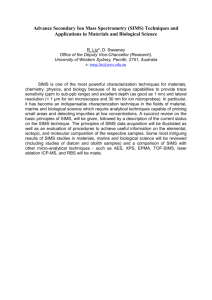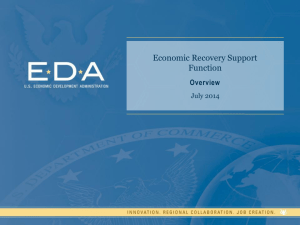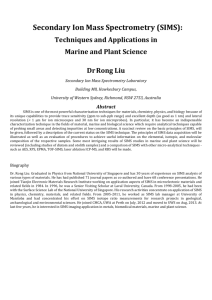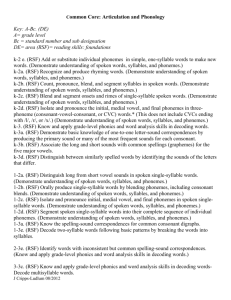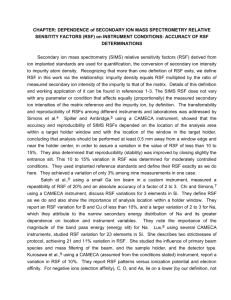CHAPTER: QUANTIFICATION
advertisement
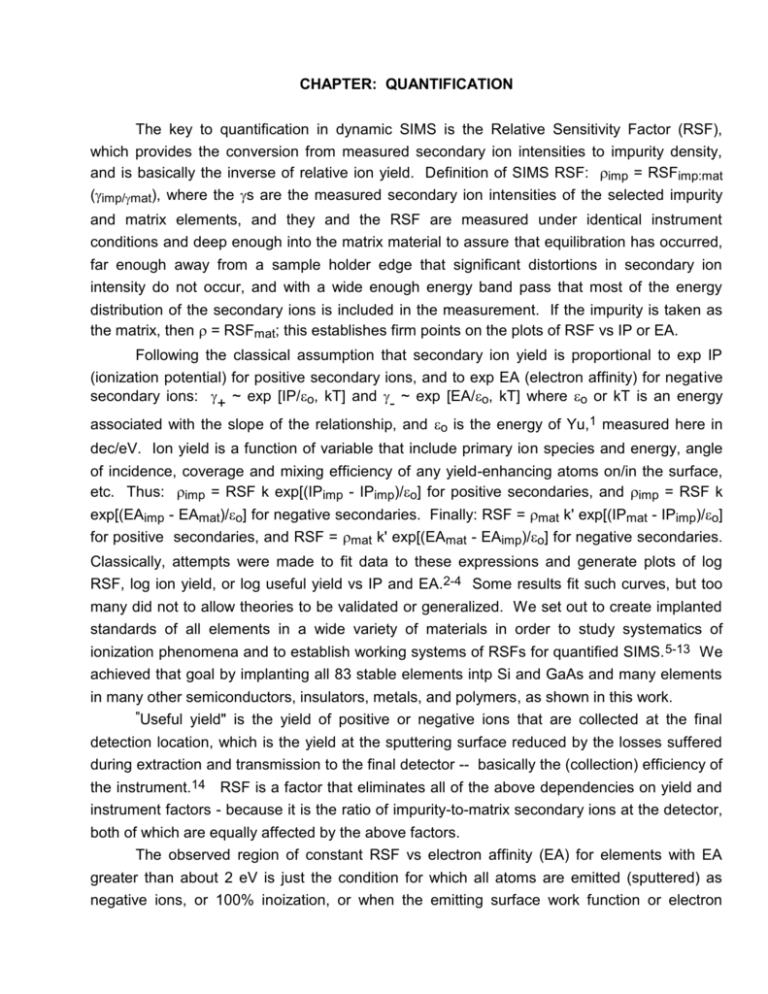
CHAPTER: QUANTIFICATION
The key to quantification in dynamic SIMS is the Relative Sensitivity Factor (RSF),
which provides the conversion from measured secondary ion intensities to impurity density,
and is basically the inverse of relative ion yield. Definition of SIMS RSF: imp = RSFimp:mat
(imp/mat), where the s are the measured secondary ion intensities of the selected impurity
and matrix elements, and they and the RSF are measured under identical instrument
conditions and deep enough into the matrix material to assure that equilibration has occurred,
far enough away from a sample holder edge that significant distortions in secondary ion
intensity do not occur, and with a wide enough energy band pass that most of the energy
distribution of the secondary ions is included in the measurement. If the impurity is taken as
the matrix, then = RSFmat; this establishes firm points on the plots of RSF vs IP or EA.
Following the classical assumption that secondary ion yield is proportional to exp IP
(ionization potential) for positive secondary ions, and to exp EA (electron affinity) for negative
secondary ions: + ~ exp [IP/o, kT] and - ~ exp [EA/o, kT] where o or kT is an energy
associated with the slope of the relationship, and o is the energy of Yu,1 measured here in
dec/eV. Ion yield is a function of variable that include primary ion species and energy, angle
of incidence, coverage and mixing efficiency of any yield-enhancing atoms on/in the surface,
etc. Thus: imp = RSF k exp[(IPimp - IPimp)/o] for positive secondaries, and imp = RSF k
exp[(EAimp - EAmat)/o] for negative secondaries. Finally: RSF = mat k' exp[(IPmat - IPimp)/o]
for positive secondaries, and RSF = mat k' exp[(EAmat - EAimp)/o] for negative secondaries.
Classically, attempts were made to fit data to these expressions and generate plots of log
RSF, log ion yield, or log useful yield vs IP and EA.2-4 Some results fit such curves, but too
many did not to allow theories to be validated or generalized. We set out to create implanted
standards of all elements in a wide variety of materials in order to study systematics of
ionization phenomena and to establish working systems of RSFs for quantified SIMS. 5-13 We
achieved that goal by implanting all 83 stable elements intp Si and GaAs and many elements
in many other semiconductors, insulators, metals, and polymers, as shown in this work.
"Useful yield" is the yield of positive or negative ions that are collected at the final
detection location, which is the yield at the sputtering surface reduced by the losses suffered
during extraction and transmission to the final detector -- basically the (collection) efficiency of
the instrument.14 RSF is a factor that eliminates all of the above dependencies on yield and
instrument factors - because it is the ratio of impurity-to-matrix secondary ions at the detector,
both of which are equally affected by the above factors.
The observed region of constant RSF vs electron affinity (EA) for elements with EA
greater than about 2 eV is just the condition for which all atoms are emitted (sputtered) as
negative ions, or 100% inoization, or when the emitting surface work function or electron
binding energy is equal to or less than the EA of the atoms being sputtered. Likewise, for
positive ions and ionization potentials (IP), for the region of IP less than about 5 eV, where the
RSF (yield) is observed to be constant with IP, all atoms are emitted (sputtered) (desorbed) as
positive ions, or 100% ionization. An explanation for the enhanced yield of F (and other
strongly electronegative elements. viz. Cl, Br, I, C, H, and N) has been suggested,15-17
namely, electron stimulated desorption (ESD), possibly originating from an Auger process (a
non-collisional process, not related to sputtering, but working in conjunction with it).
SIMS RSFs have been measured carefully under consistent instrument conditions9 and
for implanted standards mostly made in one implanter under controlled fluence conditions. A
few implants were made in a different implanter for which the fluences were checked using
Rutherford backscattering.18 The resulting RSFs show consistent patterns of RSF versus IP
and EA, with several branches or patterns with deviations for the many
(>25) materials studied.5-13 Some effort has been carried out to explain the patterns and
deviations theoretically and phenomenologically, for example by Ming Yu19 and Peter
Williams.20
The experimental conditions used in our measurements and for our compilation of
RSFs are described in reference 8 in general. Specific conditions for various SIMS
instruments may vary, but general guide lines should be similar for consistent comparisons
and use of these RSFs. We studied the influence on RSF variation of instrument conditions
for high extraction field, wide energy band pass, magnetic sector SIMS instruments (CAMECA
3f and 4f).21 In summary, standard conditions are: For positive secondary ions, 6 or 8-keV O2
primary ions (incidence angle 40±1°), for negative secondary ions, 14.5-keV Cs primary ions
(incidence angle 26°), energy band pass 128 eV unless measured under conditions of high
mass resolution (and then the same for impurity and matrix), secondary ion intensity below the
magnitude that saturates the detectors, and measurements made near the center of sample
holder windows.
A. Source of standard or RSF: Implanted or bulk doped material; published value (book
value) or quoted value; or "calculated value" from systematics.
B. How we make implanted SIMS standards: Chose ion energies, isotopes, and implant
fluences according to the types of matrices, the desired elements, and the desired SIMS
technologies, knowing generally how ion yields vary with elements and SIMS technology
(RSF), considering rarer isotopes, vacuum species, and interferences from the various matrix
combinations. Mount pieces of the selected matrix materials on the implanter target holder
using small clips in several positions with an area chosen according to the
size of the "standards" pieces. Divide the desired "standards" elements according to the ion
source type; mount the ion sources sequentially; generate ion beams of the selected
elements; mass separate the isotope or isotopes of interest (1 to 5 amu) depending on the
area to be implanted, the magnitude of mass, and the desired selectivity (The higher the
mass, the more difficult it is to achieve unit mass resolution; for some elements, monoisotopic
standards must be implanted in small areas.); and set the selected implant fluence and
perform the implant.
C. Accuracy of standard:
Bulk doped: How good is the quoted value? How is it measured? Implies natural isotopes,
so is elemental and the RSF must be partitioned among masses
Implanted: Implant fluence accuracy? 5-15% in our case, increasing with Z.
Isotope distribution of nominal quoted fluence? RSF partitioning is necessary. Some
implanted standards are limited to one isotope or to selected isotopes; this information
must be known or determined using SIMS so that the correct RSF is used for the
selected mass. Element distribution of nominal fluence - purity of implant?
Dissociation and charge exchange in commercial implanters (pre-acceleration mass
separation) can lead to incorrect energies (often 0.5 and 2x the quoted/nominal energy) and to
incorrect fluences. Molecules may occur at the same mass as the desired element: examples:
1H = 2H 12C16O = 28Si = 14N 10B19F = 29Si 11B19F = 30Si 12C19F = 31P 16O = 32S
2
2
2
28Si35Cl
= 63Cu. All of these errors can be determined by measuring isotope fingerprints
(mass spectra) of the implanter beam (or of the implants).
D. Accuracy of quantification depends on how well the standard and unknown are
profiled, that is, how accurately the RSF is determined when the standard is profiled and how
accurately the unknown is profiled for comparison. Both issues depend strongly on whether
measurements (profiles) are made in the center of a holder window. RSFs and quantification
are only as good as these two measurements. Both can be within 10 to 20% if made near the
center of a holder window (at least for a CAMECA or any high extraction field instrument). An
error of 200 to 500 % can easily occur if either measurement is made near the edge of a
holder window.
E. Accuracy of quantification is also a function of accuracy of crater measurement
made for any RSF standard profile.
Error here is probably 6 to 8% for polished
semiconductors and greater for metals, polymers/organics, and rough surfaces like minerals.
F. Accuracy of quantification depends on uniform or known sputtering rate during a
deep profile, or known sputtering rates and known RSF (ion yield) changes during profiling of
multilayer/multi-material samples. For accurate quantification throughout a deep or complex
materials profile, all variations in sputtering rate and yield change must be determined and
used in the data replots.
G. How to use RSFs:
Repeating the definition, imp = RSF (imp/mat), RSF with respect to a selected matrix
element. The RSF and impurity and matrix intensities (s) must be adjusted according to
whether they are elemental or isotopic. These adjustments are described in reference 8, but
three examples are given below, where IA means isotope abundance.
(Fe)=RSF(Fe:Si){[(54Fe)/IA54Fe(=0.058)]/[(30Si)/IA30Si(=0.031)]}
(Ge)=RSF(Ge:Si){[(70Ge)/IA70Ge(=0.205)]/[(28Si)/IA28Si(=0.92)]}
RSF(O:Si)=Si(5.0x1022 cm-3)[(18O)/1*]/[(28Si)/0.92 or (30Si)/0.031]
*unity
whenever a monoisotopic standard; if multi-isotope standard, profile the isotopes and
partition the total fluence among them, or sum the s.
Consider whether an implant standard should be run in parallel with the unknown.
H. Systematics and RSF determination
Can a published value of RSF be used, and with what confidence?
Can an RSF be estimated with sufficient accuracy for the present purpose?
If so: first calculate the total atom density of the matrix and partition it among the matrix
components -- these are the RSFs for the matrix components. Plot these values of RSF at the
IP and the EA of those elements. These values locate the RSF pattern on the RSF magnitude
scale. Draw lines through these points with the appropriate slope (~0.8 dec/eV for
semiconductors and ~0.45 dec/eV for insulators, for positive ion RSF). Have B and F
implanted in the material. Measure the positive and negative RSFs for B and F and plot them
on the two plots. For negative SIMS, draw a sloped line through the points for B and the
matrix, and a horizontal line through the point for F. The RSF for F is the RSF for all column 16
and 17 elements except O, those commonly run using negative SIMS, namely S, Se, Te, F,
Cl, Br. A separate measurement is required for O, so have an O implant made, if O is needed.
For positive SIMS, draw a line through the points for B and the matrix. Draw a line through the
point for F approximately normal to the first line. Draw a line for Be and Mg below
the main line as shown in the two references. Or better, have a Be implant made if Be is
important in the material of interest. See references: either Section 3.3 of ref. 8, or appendix
C of ref. 10.
I. Can multiple elements be profiled in the standard? in the unknown? The reference
standard may have multiple elements implanted because of impurities in the implanter beam,
or there may be mass interferences from the matrix. Mass scans can be run to answer these
questions, when accuracy is required or in cases where the standard is suspect, or if an RSF
determined from it does not agree with published values.
J. Must profiling be done using an offset voltage? If so, the unknown and a standard
must be profiled using the same offset.
K. Side issues: Should the sample be coated with a conducting film (e.g.,Au) to prevent
deleterious effects of charging? Should the sample be flooded with electrons? If so, what is
the effect on quantification? The standard should be profiled under the same conditions of
electron flooding. Should autovolting be used? What mass? The standard should be profiled
under the same conditions. Should positive or negative spectrometry be used? Should high
mass resolution be used? The standard should be profiled under identical conditions and a
special RSF should be measured, because part of the energy spectrum is cut off (reduced
energy band pass) during high mass resolution profiling.
L. Should profiling be done using Cs and positive SIMS, that is, using ECs+? If so, a
standard should be measured in parallel to measure the ECs+ RSF.
M. Caution should be exercised when using M2, M3, etc. to reduce the matrix
signal intensity, because their intensities may vary as (M)3,4 etc. Also, those signals may
disappear in materials in which the selected atom pairs are not bound, altering the probability
of dimer formation, e.g., Si in SiO2, where there are no Si-Si bonds, only Si-O bonds. Mx and
M/x may not be reproducible, so probably should not be used for careful quantification.
N. Especially Difficult Elements: (with zero or very low EA and high IP)
Element(E) IP(eV) EA(eV)
He
24.6 0.078
Be
9.3
~
N
14.5 0
Ne
21.6 0
Ar
15.8 0
Zn
9.4
0
Kr
14.0
Mg, Mn, Dy, and Hf have zero or near zero EA,
but low IPs, so use of positive SIMS with O2
0
Cd
9.0
0
primaries is satisfactory
Xe
12.1 0
Hg
10.4 0
For the above elements (as impurities), ECs+ should be considered (although the HgCs mass
is too high to be measured using a CAMECA), and the mass of HeCs is difficult to separate
from Cs.
O. See Fig. 1.8 B on page 1.8-4 of reference 8 for voltage offset and translation of
holder window.
P. When quantification seems in question or profiles appear distorted: Check crater
edge rejection (beam size, contrast diaphragm and field aperture sizes, raster dimension);
check the video display of the crater edge (darkening means non-flat sample surface); check
sample centering and flatness in holder); check the signal intensity and possible detector
saturation at the peak of the standard profile; retune and recenter; lower the primary energy
Q. What about mass interferences and the use of HMR or rarer isotopes? and the
associated trade-offs in signal intensity reduction versus natural abundance penalty? Often,
the penalties in sensitivity that result from the use of high mass resolution and a rarer isotope
that does not suffer from the interference are of approximately equal magnitudes (say 50). In
these cases, the use of a rarer isotope is recommended because of the quantification issue of
using high mass resolution caused by the reduction of the band pass energy or cutting off of a
portion of the secondary ion energy spectrum.
Example cases to consider:
Be in AlGaAs or any Al-containing material | BeAsFe in any Si-containing material | 54Fe
Si in AlGaAs or any Al-containing material (AlH-) | 30Si
Si in any material with Si or CO BG | 30Si
S if O present | 34S
H if H present | 2H
O if O present | 18O
C if C present | 13C
As in Si | offset V | AsSiP in Si | HMR
Au with Ta cover plate | Al cover plate | offset
Bi in Si with Ta cover plate | Al cover plate | offset
R. Use of Mass Spectra: Mass spectra should be used to determine and help resolve
interference issues. When high background intensities are encountered, mass spectra should
be run to determine the source of the signal and therefore how to improve profiles, or using
rarer isotopes, offset voltages, or HMR as aids. Mass spectra also help in choosing what
isotope to use to fabricate optimum
SIMS reference standards.
S. Potential problems with implanted standards:
* Incorrect ion at chosen mass was implanted, leading to no calibration
* interference(s) at chosen mass along with the correct mass (ion), causing incorrect fluence
and incorrect RSF
* Incorrect energies of the correct ion (mass) that result from dissociation or charge
exchange, leading to incorrect fluence and extra peaks or bumps in the depth profile
(shallower or deeper), and thus to incorrect RSF
* poor secondary suppression. leading to incorrect fluence and RSF
* more than one isotope of the element requested (when a specific isotope was requested),
and only one isotope is profiled, which can be correct for by SIMSing several isotopes
of the element requested for a standard
* interferences among multiple calibration implants in the same matrix area - an issue only
when multiple calibration implants are requested - can be avoided by careful
consideration of masses before request is made
* insufficient implant energy, leading to a significant part of the depth profile being within the
surface equilibration depth of SIMS
Some implanters do not have unit mass resolution for higher masses, so monoisotopic
implants are difficult or impossible. Some implanters suffer from dissociation or charge
exchange and can implant incorrect energies and fluences. Some implanters do not have
adequate secondary suppression of both positive and negatibve secondary ions at the surface
of SIMS standards.
T. New RSFs:
Since the publication of reference 8, we have measured RSFs for some elements that were
previously not measured and have checked and modified some that were previously reported.
This new material is now included in other part of this work
Conclusions
Dynamic SIMS is now a well quantified technology in many different types of materials, and
can be quantified in any material that can have the sputtered crater depth measured, through
the use of implanted standards for many elements. Many of the issues involved in
quantification of dynamic SIMS have been reviewed here.
References
1. M. L. Yu, Nucl. Instrum. Meth. Phys. Res. B18, 542-48 (1987); See also M.L. Yu and K.
Mann, Phys. Rev. Lett. 57, 1476-79 (1986)
2. C.A. Anderson and J. R. Hinthorne, Science 175, 853 (1972)
3. V.R. Deline, C.A. Evans, Jr., and P. Williams, Appl. Phys. Lett. 33, 578 (1978)
4. A. Lodding, H. Odelius, and L.G. Peterson, Secondary Ion Mass Spectrometry SIMS
IV, Ed. A. Benninghoven et al. [Springer, Berlin, 1984] p.478-484
5. R.G. Wilson, J. Appl. Phys. 63, 5121 (1988)
6. F.A. Stevie and R.G. Wilson, Secondary Ion Mass Spectrometry SIMS VII, A.
Benninghoven, C.A. Evans, K.D. McKeegan, H.A. Storms, and H.W. Werner, Eds.
[Wiley, NY, 1990] pp. 159-162
7. S.W. Novak and R.G. Wilson, Secondary Ion Mass Spectrometry SIMS VII, A.
Benninghoven, C.A. Evans, K.D. McKeegan, H.A. Storms, and H.W. Werner, Eds.
[Wiley, NY, 1990] pp. 87-90
8. R.G. Wilson, F.A. Stevie, and C.W. Magee, Secondary ion mass spectrometry: A
practical handbook for depth profiling and impurity analysis, [Wiley, NY, 1989]
9. S.W. Novak and R.G. Wilson, J. Appl. Phys. 69, 463-65 (1991)
10. R.G. Wilson and S.W Novak, J. Appl. Phys. 69, 466-74 (1991)
11. F.A. Stevie and R.G. Wilson, J. Vac. Sci. Technol. A9, 3064-70 (1991)
12. R.G. Wilson, F.A. Stevie, G. Lux, C.L. Kirschbaum, S. Frank, and J. Pallix, Surface and
Coatings Technol. 51, 358-363 (1992)
13. R.G. Wilson, G.E. Lux, and C.L. Kirschbaum, "Depth profiling and secondary ion mass
spectrometry relative sensitivity factors and systematics for polymers/organics," J. Appl.
Phys. 73, 2534-29 (1993)
14. P. Williams, Practical Surface Analysis, Vol. 2 "Ion and Neutral Spectrometry" Ch. 4
Ed. Briggs and Seah [Wiley, 1992] This is a good history and review of SIMS
15. B.G. Atabaev, E.D. Besedina, M.S. Kareev, and R. Dzabbarganov, Surface and Interface
Analysis 16, 475-79 (1990)
16. A.-M. Lanzillotto and C.W. Magee, J. Vac. Sci. Technol.A8, 983-86 (1990)
17. M. Petravic and J.S. Williams, "Ion-induced noncollisional ejection of positive secondary
ions," Surface Science (1991 - North Holland)
18. F.A. Stevie collaborated in this effort
19. M.L. Yu, "Fundamentals of SIMS," Presented at the Fifth East Coast Workshop on SIMS,
Hidden Valley PA, 20-22 May 1992
20. P. Williams, "Quantitative aspects of SIMS depth profiling," Presented at the Fifth East
Coast Workshop on SIMS, Hidden Valley PA, 20-22 May 1992; Secondary Ion Mass
Spectrometry SIMS VII, Ed. A. Benninghoven, C.A. Evans, Jr., K.D. McKeegan, H.A
Storms, and H. Werner [Wiley, NY, 1990] p. 15
21. G.E. Lux, S.P. Smith, and R.G. Wilson, "Dependence of SIMS relative sensitivity factors
(RSF) on instrument conditions: Accuracy of RSF determinations," SIMS VIII,
Amsterdam, Sept 1991
